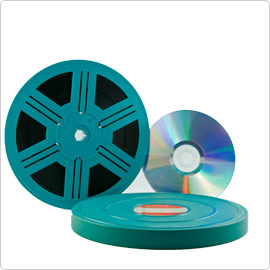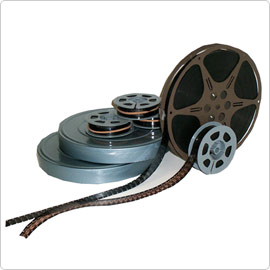8mm & 16mm film transfers
Your Regular 8mm, Super8 and 16mm home movies are special. They were recorded and saved for all these years to be passed on to your future generations. The conversion process from film to digital is what will determine how much of these memories they will actually see. At Canada Home Movies we are one of the FEW companies that not only uses film scanners to digitize your film, but we actually have professional editors that then review and edit the footage and create high bitrate HD and tranditional DVD discs.
Do not trust your film transfers to just anyone.
We NEVER have flicker, jitter or bad focus.
Your film is colour corrected, your DVD or
Blu-ray has a reel menu with each reel separated.
We take pride in our work. We work hard to
"Save your Memories".
Film formats that we transfer
Regular 8mm to DVD | Super8 to DVD | Super8 with sound to DVD | 16mm to DVD | 16mm with sound to DVD | Other films to DVD
Regular 8mm to Hard drive | Super8 to Hard drive | Super8 with sound to Hard drive | 16mm to Hard drive | 16mm with sound to Hard drive
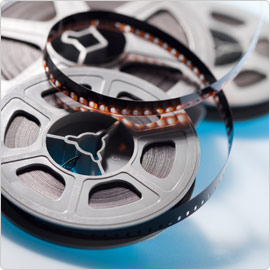
Regular 8mm Film
The Regular 8 (also called standard 8 or double 8) film format was introduced to market in 1932 by the Eastman Kodak company. The goal was to create a home movie film format that was cheaper than the 16mm film. Regular 8 film runs at 16 or 18 frames per second and a standard 3" reel contains 3min 42sec or 4min 10sec of footage respectively.
Regular 8 film does not have sound (with some very rare exceptions) but we can add a pleasant instrumental soundtrack or your own music if you desire.
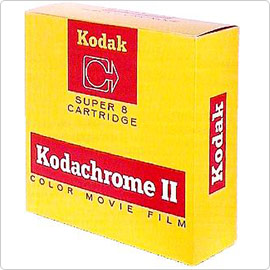
Super8 Film
Super8 film is the evolution of Kodak's Regular 8 home movie film. They key improvement of Super8 over Regular 8 film is the size of the film "frame". Super8 has smaller sprockets (perforations on the edge of the film) which allows for more space for the actual image on the film. Super8 format also introduced the option of recording sound together with image on the film. This feature however didn't get much traction and out of all Super8 film that we transfer only about 5% has sound.
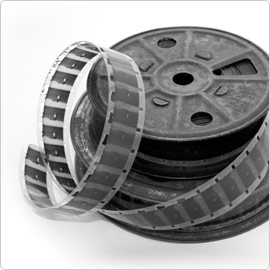
16mm Film
16mm film is one of the oldest still manufactured film formats and one of the most popular film formats ever produced. Originally introduced in 1923 by Kodak, 16mm has been used for almost 90 years by home, amateur and professional users. 16mm film has a much larger frame size that 8mm film and therefore has a more detailed and sharper image - it also looks terrific on Blu-ray discs.
Why we are better.
There are many companies who offer to transfer your 8mm or 16mm films to digital, so why choose us?
In addition to being the most experienced transfer house in Canada, having multiple real studios to serve you better (No, we don't project your film to DVD in the back of the convenience store), your film to DVD or computer file transfers will also benefit from our streamlined process described below.
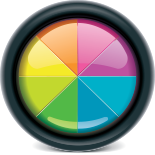
Perfect Colour
We only use professional equipment. This allows us to get the best possible image even from the oldest and most worn video tape.
We only use professional equipment. Most videotapes consist of a layer of tiny magnetic particles applied to Mylar, a strong, flexible plastic material. One of the most unfortunate issues with video tape is that the more it was used the more likely the tape has been deformed. Usually tape streaching causes problems with video drop outs that look like a band that crossed the screen. In some cases no matter how much you try to adjust the image you cannot get a stable video feed.
Of course, audio is severely affected where in many cases it's impossible to get any clear sound at all. By utilizing professional tape players it give us a much larger base to work from. We can adjust your footage twice as much as consumer equipment. Your tape will not only look better but sound better.
Our equipment is serviced regularly by the dealers and undergo routine testing to ensure the highest possible conversions at all times. But just like the computer saying video tape conversions start with perfect quality in equals perfect quality out.

Perfect Sharpness
Unlike the common projection method, our propriotary film scanners have set focus. This means that your film will always be perfectly focused
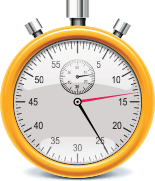
Perfect Film Speed
Film reel is a collection of thousands small pictures positioned one after another. Different films have different speeds that they were recorded at. Our film scanning process takes a still image of each one of those frames and sends it to a computer. Once all images are in our editing software, we will specify the exact frame rate at which your film is supposed to run and there you go - your film is at the exact speed that it's supposed to run at.
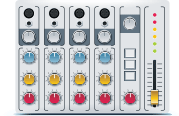
Full Editing
Once your film is scanned into our computers, a fulltime video editor will review and edit your footage.
Here is what is included with every film transfer service:
- We'll remove any unviewable footage, such as film leaders, any footage that was originally completely under or over exposed and any other footage that has no value.
- People often used incorrect film for indoor or outdoor shooting. This results in red or blue tint in your film. We will colour correct your footage to represent real colours as they were meant to be.
Ship in your films for us to convert
Keep your memories safe. Ship using a bonded courier. Take your footage to any FedEx or UPS Store. All the necessary shipping materials you need will be provided right there and their associates may even package your media for you. As these memories are usually irreplaceable we suggest taking the time to double box and use bubble wrap.
Choose a carrier that offers delivery confirmation to ensure the safest, most direct delivery possible. Once you have the tracking number send us an email with the number. We will watch out for the order and will contact you as soon as it comes in. One of our associates will also, at that time, spend a few minutes review your order with you and ensure we completely understand your needs.
Price list
We are developing our order building application for video cassette conversion pricing. Until then, please fill out the form below or give us a call at 416 479 0537 and we'll give you a no obligation quote.
See our price list
